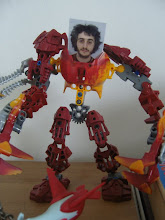
Tuesday 17 June 2008
Elumotion Arm
Started work a few weeks ago on controlling an anthropomorphic upper limb manufactured by Elumotion. At the moment I'm just using it as a hardware test bed in anticipation of working on a full humanoid torso however the anthropomorphic nature of the device means that certain motions can make you feel rather uneasy. This is the Uncanny Valley principle in action as one could say the arm looks like part of a 'moving corpse'.


Friday 6 June 2008
Insect Braitenberg Vehicle
A few days ago I observed an insect behaving like a simple mobile robot (Braitenberg vehicle) with a line-avoiding algorithm. I ran and got my camera and the video below is the result.
Obviously Braitenberg designed his thought-experiment vehicles with insect behaviors in mind, a light stimulus to the right eye drives the left locomotor (wing / set of legs) to result in a moth that is attracted to light (or a 'photovore' in the case of the robotic vehicles).
By simple modification of this algorithm you can produce a creature that prefers darkness and can be made to follow a dark line on a light background (the dark line reflects less light into its sensors).
This insect appeared to be avoiding dark lines which makes sense as insects like light. But do insects really apply these rules to their perception of the environment on such a local level? The geek in me cries out for formalised experiments!
Unfortunately the best example (where it stayed in a circle for around 20 seconds) isn't on film (as it was what inspired me to get the camera).
It has crossed my mind that perhaps it doesn't like wet ink... some of the occasions where the insect stays in a circle for a while might disprove this but then it walks over some of the older lines quite happily.
I'd be very interested to hear people's opinions about this video...
Obviously Braitenberg designed his thought-experiment vehicles with insect behaviors in mind, a light stimulus to the right eye drives the left locomotor (wing / set of legs) to result in a moth that is attracted to light (or a 'photovore' in the case of the robotic vehicles).
By simple modification of this algorithm you can produce a creature that prefers darkness and can be made to follow a dark line on a light background (the dark line reflects less light into its sensors).
This insect appeared to be avoiding dark lines which makes sense as insects like light. But do insects really apply these rules to their perception of the environment on such a local level? The geek in me cries out for formalised experiments!
Unfortunately the best example (where it stayed in a circle for around 20 seconds) isn't on film (as it was what inspired me to get the camera).
It has crossed my mind that perhaps it doesn't like wet ink... some of the occasions where the insect stays in a circle for a while might disprove this but then it walks over some of the older lines quite happily.
I'd be very interested to hear people's opinions about this video...
Tuesday 3 June 2008
Ad in a book (new and used)
Have just discovered that one of my papers has been published in a book available from Amazon for $180 -$539 (here is the link). The editor was the chair at a conference on Augmented Cognition that I presented at in 2005.


Here is the blurb:
"Bringing together a comprehensive and diverse collection of research, theory, and thought, this volume builds a foundation for the new field of Augmented Cognition research and development. The first section introduces general Augmented Cognition methods and techniques, including physiological and neurophysiological measures such as EEG and fNIR; adaptive techniques; and sensors and algorithms for cognitive state estimation. The second section discusses Augmented Cognition applications such as simulation and training, intent-driven user interfaces, closed-loop command and control systems, then goes on to explore lessons learned to date, and future directions in Augmented Cognition-enabled HCI."
Subscribe to:
Posts (Atom)

